In aquascaping Iwagumi-layouts are favourably designed as rock formations in grassy landscapes. By now a large selection of bladed plants or plants with blade-like leaves have become available which can be used to create a grass-like look in a layout. Here are a few tips for the different design layers (foreground, middle ground, background) of an aquarium.
Grass-like ground cover
Many ground cover are available on the market, suitable for creating a dense, lawn-like covering of the foreground. In general, many of these plants are fairly undemanding, propagate through runners and thereby spread very well. In the following, we’ll present some grass-like ground cover in greater detail.
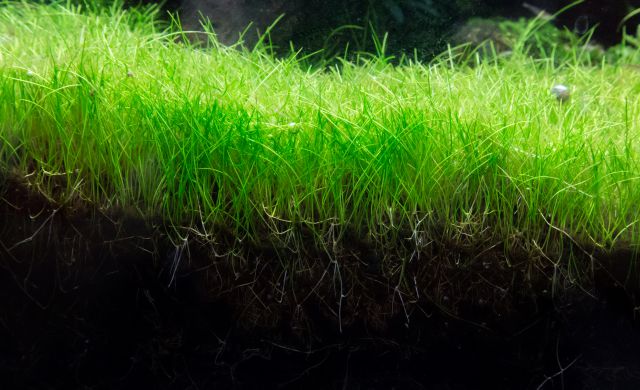
Eleocharis types
Under the trade name "hairgrass", various Eleocharis species and varieties are available for plant aquariums. All have very thin blades, so that they fit well in a nano aquarium’s size ratio. Dwarf hairgrass is available at leading nurseries under the names Eleocharis pusilla or Eleocharis parvula. Another variant would be the sp. 'Mini', which supposedly stays even smaller.
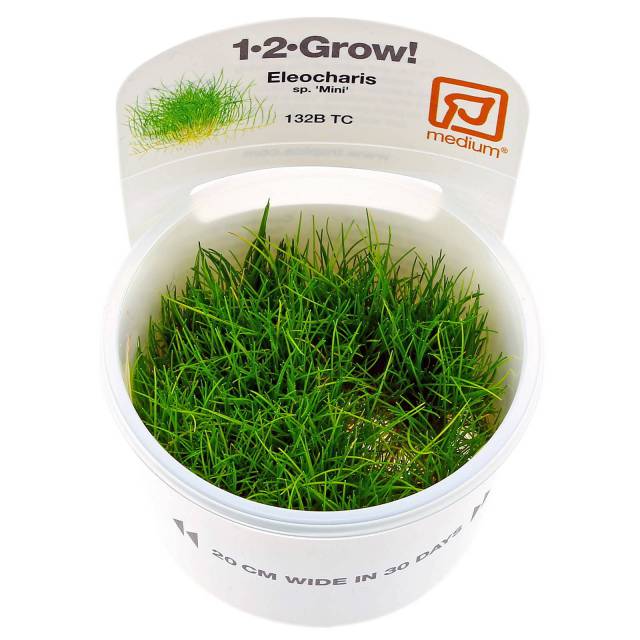
All hairgrass are rather moderate in their demands in light and nutrition, but grow significantly better with additional CO2 supply and liquid fertilization. A substrate rich in nutrients is useful, too.
Brazilian micro sword
Lilaeopsis brasiliensis is even less demanding as Eleocharis, has wider blades and a height of roundabout 6 cm. Due to the leaf size it looks better in a bigger tank.
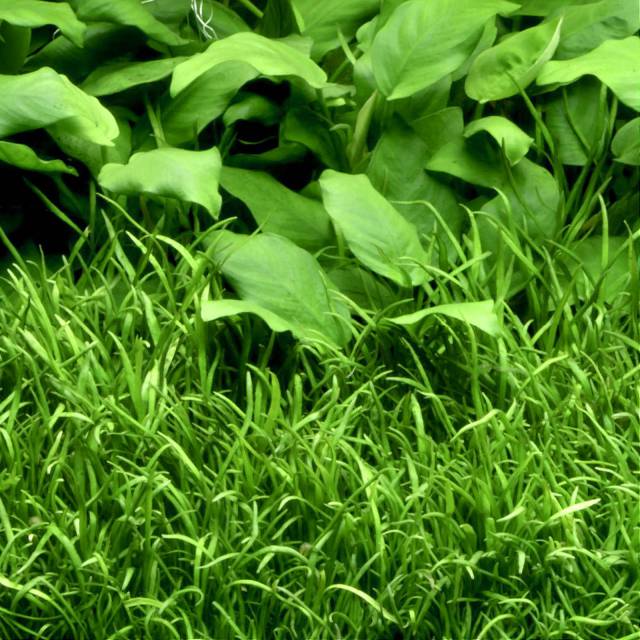
The brazilian micro sword grows rather slowly and is quite adaptable in terms of water levels. Even a keeping in brackish water is possible. Sometimes other Lilaeopsis types are commercially available as well, such as L. mauritiana or L. macloviana. These sprout much longer leaves and are water plants better suited for the middle- or background of the aquarium.
Utricularia graminifolia
The Grass leaved bladderwort is a very interesting plant, but unfortunately not easy to keep. Especially during the running-in of a new aquarium, this plant tends to just dissolve. The chances for success are much higher in established aquarium systems, where the soil is not as fresh anymore. Visually, this plant looks great because it forms a dense carpet with lying stalks.
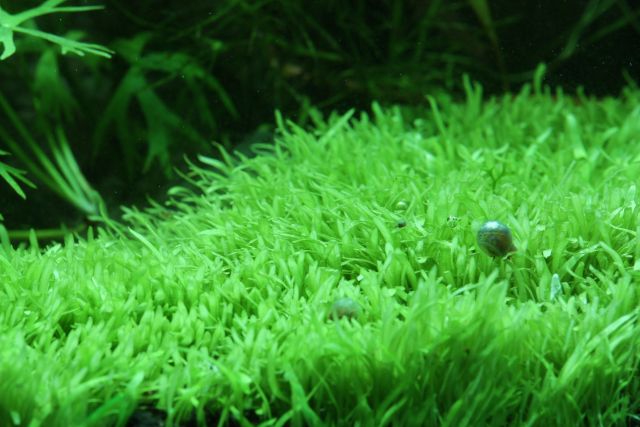
In keeping, Utricularia graminifolia is a more demanding plant that needs sufficient light, CO2 and liquid fertilizer additions. The owner is rewarded with a very dense carpet with light green stalks. Due to its small size, the plant is well-suited for aquascaping and nano-aquariums.
Middle ground plants with a gramineous look
In the middle ground of an aquarium the aquatic plants are allowed to grow a little higher than in the foreground. Again, there is a wide selection of medium-sized grassy aquarium plants available.
In the middle ground, a broad growth via offshoots is not always desired. If you want to set individual accents with grassy plants, this can best be achieved with solitary plants. Cryptocorynenes are particularly suitable for this purpose.
Cryptocorynes
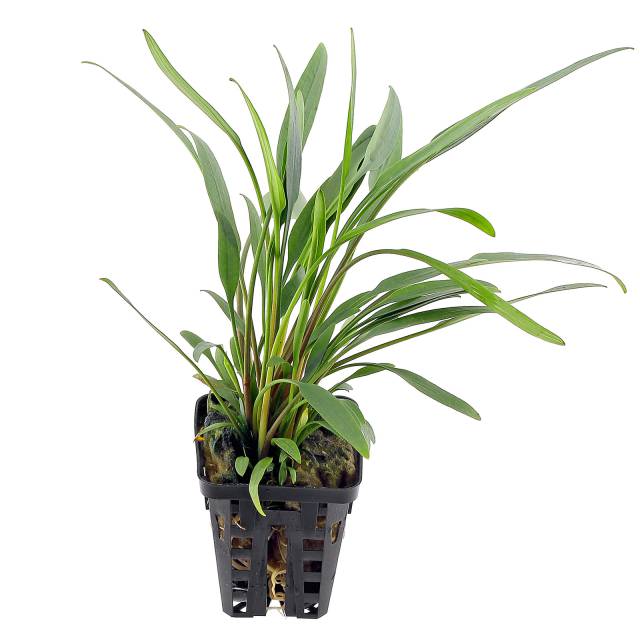
Water trumpets have the advantage of site fidelity, are often modest in terms of water levels and nutrients, and are very well suited as single accents. Amongst them we’ll also find plants, which support the grass optics by thinner and lancet-like leaves, as e.g. Cryptocoryne parva or Cryptocoryne × willisii "lucens" (see picture). Like almost all strongly root-feeding aquatic plants, water trumpets benefit greatly from a nutrient-rich substrate.
Blyxa japonica
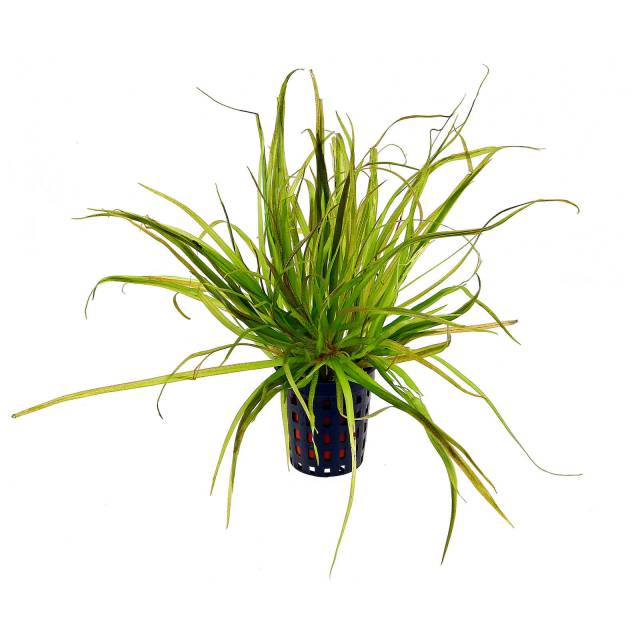
The Japanese rush is a bladed plant as well, which also creates a beautiful contrast with its colouring. Depending on the light and nutrient situation, the leaf colour varies from light green to gold to red and magenta. This pure underwater plant is a bit difficult to break in, but rather easy to keep, after establishing itself in the aquarium. Their demands in light and nutrients are classified as "medium", an adequate supply of CO2, micro- and macronutrients as well as moderate to intense illumination should be available.
Eleocharis
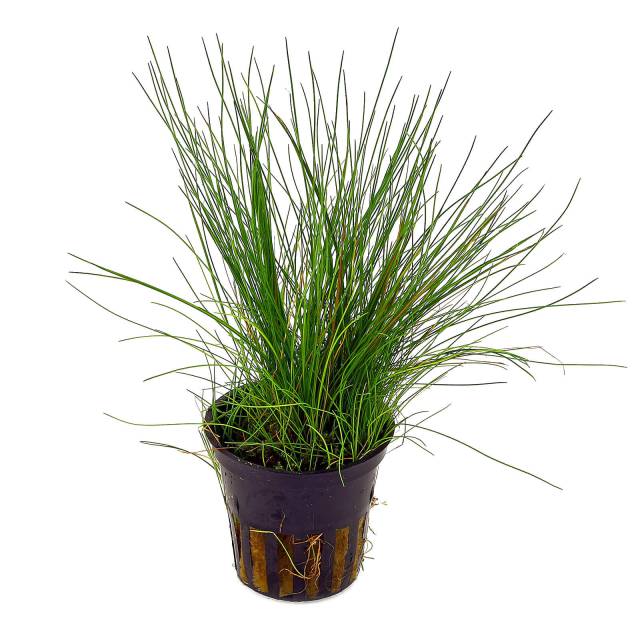
Eleocharis acicularis is a hairgrass growing to a height of up to 10cm and well suitable for middle ground planting. It has very thin green stems and proliferates via offshoots. Due to the extensive growth, this plant is not so well-suited as a single accent or it must be kept in check accordingly, if this effect is desired. A full supply with all nutrients and enough light should be provided.
Echinodorus
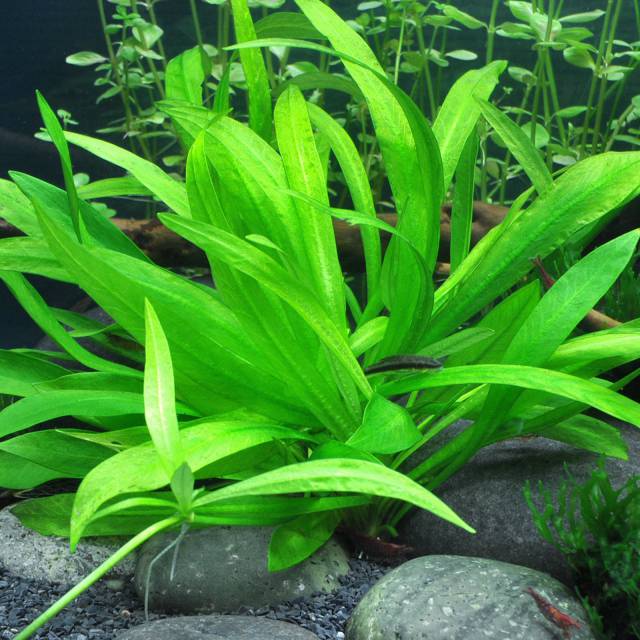
Among the aquatic plants of the genus Echinodorus or Helanthium some species are also blessed with rather thin, grassy leaves, which are suitable for the fore- to middle ground of an aquarium. Helanthium bolivianum "quadricostatus", the chain sword (see picture) has light green, narrow leaves, is rather undemanding and creates offshoots. Helanthium tenellum is a bit smaller and has a changing colour from green to reddish depending on lighting and fertilization. Targeted root fertilization, for example via fertilizer balls or nutritious soil, promotes the growth of these plants.
High grasses for the background
Of course there are plants available for the background, too. Tall-growing plants with a grass-like look and long, blade-like leaves. In part, these plants can become quite long and their leaves will then flood on the water surface. Here are some varieties for the background of the aquarium.
Vallisnerien
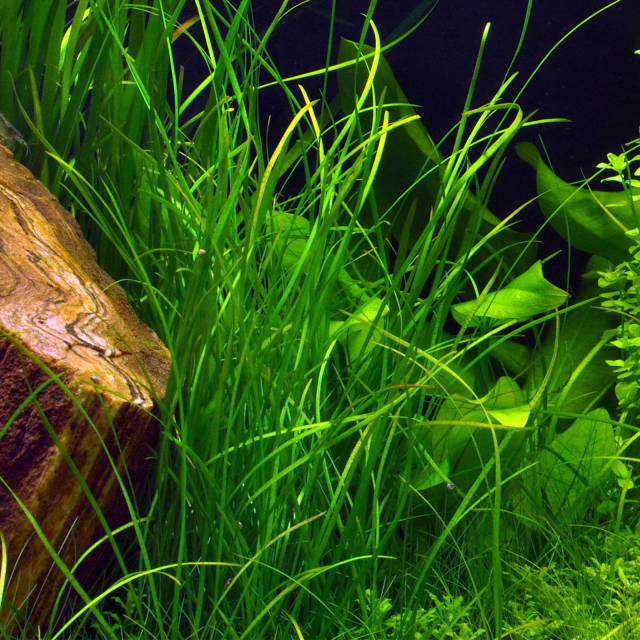
Plants of the genus Vallisneria are of course the “classic” among background plants. In addition to the standard variety Vallisneria australis genera such as Vallisneria nana (see picture) are available, which have even thinner leaves and look great in a nano tank. Vallisneria are very robust and easy to keep aquatic plants, which in addition also grow pretty quickly.
Eleocharis
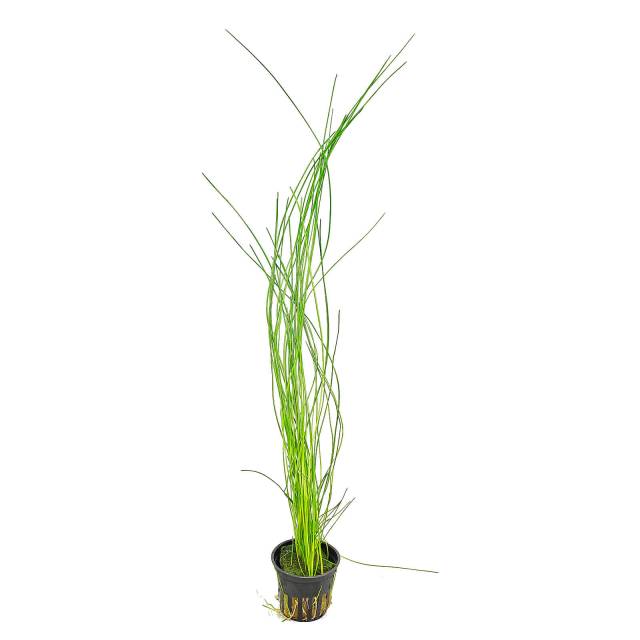
Tall-growing hairgrass genera such as Eleocharis sp. "montevidensis" (see picture) or Eleocharis sp. "Xingu" bring the grassy look in the back of the tank, too. Eleocharis vivipara is characterized by the development of young plants at its leaf ends. Thus, quite voluminous, denser braids of stalks can grow, which provide a unique growth shape. Like all species of hairgrass, the background plants should also be supplied with sufficient nutrients and light. Otherwise, growth would be severely limited.
Cryptocorynes
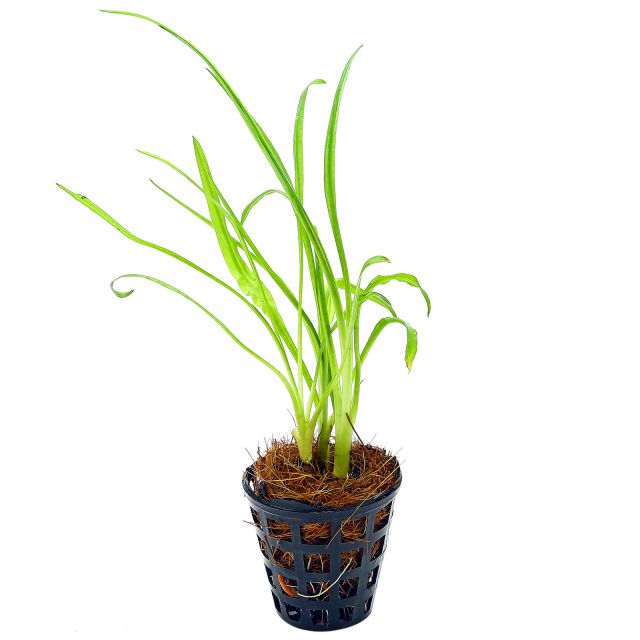
For the background, tall water trumpets are a good choice, too, especially for planted aquariums with less sophisticated species. Cryptocorynes like Cryptocoryne albida 'Brown', Cryptocoryne spiralis, Cryptocoryne sivadasanii or Cryptocoryne retrospiralis (see picture) from longish and narrow leaves, but differ in colour and leaf shape. They can be used well in the middle- and background of an aquarium.
Juncus repens
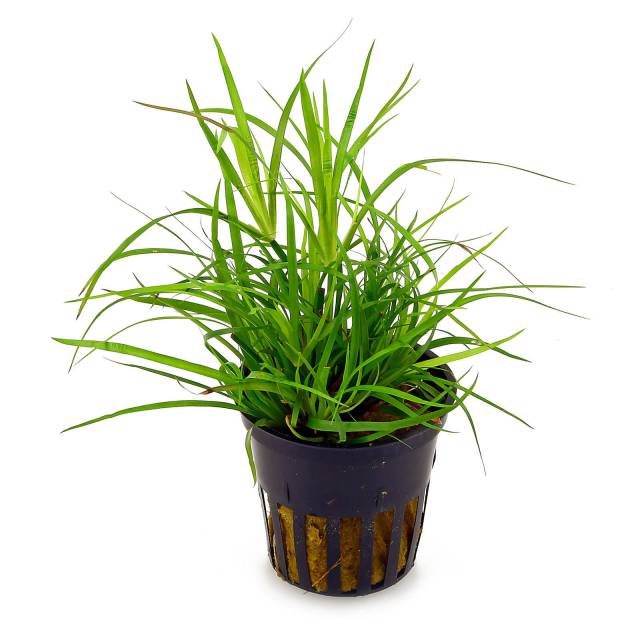
An interesting plant for the middle- and background is Juncus repens, the creeping rush. This grassy stem plant, in contrast to many other blade-leafed water plants has a rather bushy growth. In weak to moderate lighting, the shoot tips remain bright green. If more light is available and the plant is sufficiently supplied with micro- and macronutrients, the color of the tips can change from red to magenta. Nevertheless, Juncus repens remains slow-growing.
Repetition of leaf shapes
For a most harmonious impression, an aquascaper can use aquatic plants that are of different genera but have similar leaf shapes. The use of various grassy plants provides a natural impression. Due to the different lengths, sizes and shades you still have many possibilities of creating a diverse and exciting design.

An Iwagumi layout by Tobias Coring. Many different gramineous aquatic plants were used here. Some genera with round leaves such as Anubias and Staurogyne break through the structures and give the ensemble emotion and variety.
Variety through different leaf shapes
On the other hand, excitement and variance can also be generated by different leaf structures in an aquarium layout. In a design with predominantly blade-leafed aquatic plants, plants with rounded leaves can provide variety. And especially when going for a grassy landscape, there are great opportunities that complement each other well. An additional ground cover like Marsilea hirsuta can loosen up a thick underwater lawn made of e.g. Eleocharis parvula. The cloverleaf-like structure preserves the visual impression of a meadow.